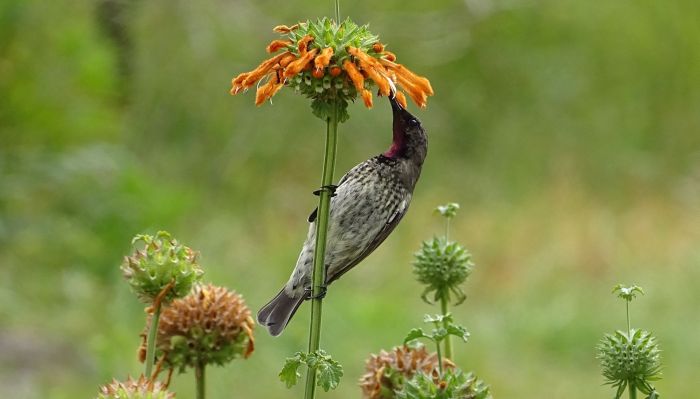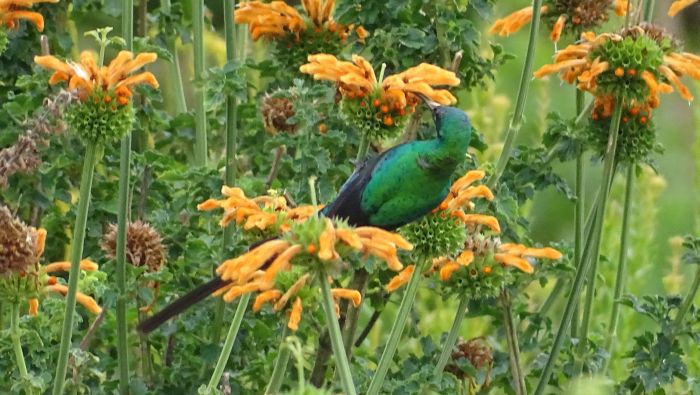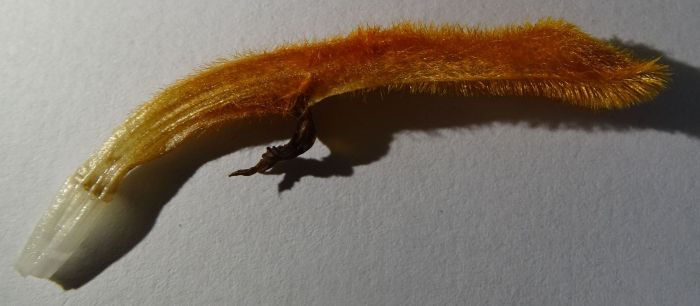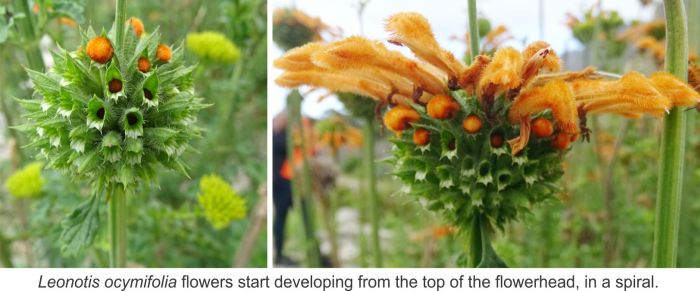Leonotis ocymifolia
Leonotis ocymifolia (Burm.f.) Iwarsson
Family: Lamiaceae
Common names: rock lion's paw, minaret flower (Eng.); klipdagga, wildedagga (Afr.)
Introduction
Leonotis ocymifolia, the lesser known relative to the well-known Leonotis leonurus, is in many ways as worthy of recognition, not only for its usefulness, but also for its ease of growth and hardiness in the waterwise garden.

Description
Description
Leonotis ocymifolia has a similar growth form to L. leonurus. It is a roughly hairy shrub and grows to a height of 1–2 m. It branches from a thick, woody base and has widely spaced internodes along the stems. The leaves are stalked, ovate to almost round, with toothed margins. The upper leaf surface is smooth to finely hairy, whereas the lower surface is silvery.

The flowers, which appear in spring in the Overberg and flower until mid to late summer (September to May), are orange, velvety, 40–55 mm long and appear in well-spaced, ball-shaped whorls and look very similar to the well-known L. leonurus flowers.

Conservation Status
Status
According to SANBI’s Red List of South African plants, Leonotis ocymifolia is assessed as Least Concern (LC).
Distribution and habitat
Distribution description
Leonotis ocymifolia is widespread throughout eastern Africa and southern and eastern South Africa. It occurs in Namibia, eSwatini (Swaziland), in the four northern Provinces of South Africa, and in the Free State, KwaZulu-Natal, Eastern Cape and Western Cape. It is found growing on rocky slopes and forest margins, and depending on where it is growing, it receives rainfall in winter or summer.

Derivation of name and historical aspects
History
The genus name Leonotis is derived from Greek, leon meaning ‘lion’ and otis, meaning ‘ear’ and alludes to the resemblance of the corolla to a lion’s ear. The species name, ocymifolia, means with leaves like basil plants (the genus name of basil is Ocimum, and folia means leaves).
There are approximately 12 species within the genus Leonotis, 10 of which occur in South Africa.

Ecology
Ecology
The klipdagga is pollinated by bees and a number of different birds, including Double-collared Sunbird, Amethyst Sunbird and Malachite Sunbird, observed in the Harold Porter National Botanical Garden. These birds that pollinate the flowers have long curved beaks that fit into the flowers perfectly, as they search for nectar. The anthers, which are the pollen presenters, reach just outside of the tubular flower and are positioned on top. When a bird visits the flowers, the pollen is rubbed off onto the bird’s forehead, just above its beak. As the bird moves from flower to flower, the pollen is rubbed off from the bird’s forehead, onto the stigma, thereby ensuring cross pollination between populations of L. ocymifolia.
The flowers start developing from the top of the flower head, in a spiral. As the top flowers age, the bottom flowers are developing. Therefore, on one flower head one will find seed developing and ripening in the old flowers on the top first, whereas new flowers are still developing below. Seed is released once ripe and the seed head turns brown. With the shaking of the flower head, seeds are dispersed.

Uses
Use
Fresh or dried material made up of leaves, smaller stems, occasionally with flowers and fruits, are collected as needed or sold in the market place. This material is used mainly to make an aqueous infusion or as a decoction taken orally or applied externally.
In some areas, this plant is used traditionally, for the same medical conditions as L. leonurus. Uses include the treatment of diabetes, hypertension, anemia, eczema and several other skin irritations. It is also used as a laxative and as a substance to help stimulate or increase menstruation

Growing Leonotis ocymifolia
Grow
The klipdagga is fast growing and can be propagated by cuttings or seed. The seed develops and is held in the spiky sepals on the flower head and can be collected once they ripen and turn black and the sepals turn brown. Fill a seed tray with a mixture of composted bark and coarse river sand. Press the medium down evenly and firmly. Water the medium and allow it to drain. Once drained, the seed can be sown evenly on the damp soil surface and covered with a thin layer of the medium. Trays are to be kept in a warm semi-shaded area and watered daily until seeds start to germinate and the seedlings emerge. Once the seedlings are showing, reduce watering to 3 or 4 times a week.
Semi-hardwood stem cuttings can be taken in the late spring or summer months. Cuttings with internodes close to one another should be chosen and soft tips can be pinched out. Cutting material must be collected before 10 am to prevent the cuttings from suffering from heat stress. Material collected should be placed in a clear or light-coloured plastic packet with some water, to help keep the cuttings cool.
A propagation medium used for rooting should be well draining. A combination of sifted bark, coir and perlite at a 1:1:1 ratio can be used. Once cuttings are made with the lower leaves removed, they are to be dipped in a rooting hormone specifically for semi-hardwood cuttings. The cutting is inserted into the tray with the rooting medium, with no less than 3 nodes inserted into the soil. The trays with the cuttings are then placed under mist irrigation in the glasshouse, where the medium is kept moist, but not soaking wet and the leaves are kept damp in order to slow down transpiration from the leaf surface. After 3 to 4 weeks, cuttings will root. Once the cuttings have rooted, remove the cuttings from the misting unit and place them in the hardening-off unit where they will receive longer cycles of irrigation, but less frequently throughout the day. This helps to promote root growth and allows the rooted cutting to adjust to the new conditions, before being potted into a bag with potting soil.
When the rooted, hardened-off cuttings are ready to be potted, pot them into a well-drained potting medium. Newly potted plants are to be placed in a semi-shaded area for 2 weeks and then moved out into the full sun. When they are ready to plant out into the garden, they can be placed in a sunny area in the garden bed or in a rockery. L. ocymifolia is very easy to grow and is a very hardy plant. Plants can be planted in the rainy season, to allow them the chance to become established. In the warm months they can be watered up to 3 or 4 times a week.
References
- Brown, N.A.C. & Duncan, G.D. 2006. Grow fynbos plants. Kirstenbosch Gardening Series. South African National Biodiversity Institute, Cape Town.
- Clarke, H. & Charters, M. 2016. The illustrated dictionary of southern African plant names. Flora & Fauna Publications Trust, Jacana, Johannesburg.
- Curtis-Scott, O., Goulding, M., Helme, N., McMaster, R., Privett, S. & Stirton, C. 2020. Field guide to the Renosterveld of the Overberg. Struik Nature, Cape Town.
- Germishuizen, G. & Fabian, A. 1997. Wild flowers of northern South Africa. Fernwood Press, Vlaeberg, Cape Town.
- Goldblatt, P. & Manning, J. 2000. Cape Plants. A conspectus of the Cape flora of South Africa. Strelitzia 9. National Botanical Institute, Pretoria & Missouri Botanical Garden, Missouri.
- Harris, G. & Harris, M.W. 1994. Plant identification terminology, an illustrated glossary. Spring Lake, Utah.
- Leonotis ocymifolia herba. Http://pza.sanbi.org/sites/default/files/info_library/leonotocym%20%281%29.pdf. Accessed 18/11/2020.
- Manning, J. 2001. Eastern Cape. South African Wild Flower Guide 2. Botanical Society of South Africa , Cape Town.
- Pooley, E. 1998. A field guide to wild flowers Kwazulu-Natal and the eastern region. Natal Flora Publications Trust, Durban.
- Smith, C.A. 1966. Common names of South African plants. Memoirs of the Botanical Survey of South Africa No. 35. Government Printer, Pretoria.
- Turner, S. 2001. Leonotis leonurus (L.) R.Br. PlantZAfrica. Online. http://pza.sanbi.org/leonotis-leonurus
Credits
Karen Wall
Harold Porter National Botanial Garden
December 2020
Plant Attributes:
Plant Type: Shrub
SA Distribution: Eastern Cape, Free State, Gauteng, KwaZulu-Natal, Limpopo, Mpumalanga, North West, Western Cape
Soil type: Sandy, Loam
Flowering season: Spring, Early Summer, Late Summer, Autumn
PH: Acid
Flower colour: Orange
Aspect: Full Sun
Gardening skill: Easy
Special Features:
Horticultural zones










Rate this article
Article well written and informative
Rate this plant
Is this an interesting plant?
Login to add your Comment
Back to topNot registered yet? Click here to register.